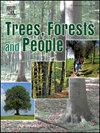Ecosystem services values for local people in participatory forestry context: The case of karura urban forest reserve
IF 2.7
Q1 FORESTRY
引用次数: 0
Abstract
While green urban infrastructure has been widely successful in the global North to ease the pressure from rapid urbanization, developing economies in the global South are also embracing sustainable urban planning by integrating forest management approaches that prioritize ecological benefits of urban forests. Karura Forest Reserve (KFR) in Kenya is an important urban forest ecosystem that provides multiple benefits to the residents of Nairobi city. Our research addresses a significant gap in the literature by exploring the benefits provided by KFR to the local community. The aim is to evaluate the ecosystem services provided by KFR to the local people, with the objectives (i) to estimate the direct and indirect benefits of employment for Friends of Karura Community Forest Association (FKF-CFA) members, (ii) to evaluate the effect of periodic deadwood removal by the Huruma community-based organizations (CBOs), and (iii) to provide a holistic economic perspective based on total revenue from entrance fees. We used survey methods to collect primary data by applying mixed format questionnaires to FKF-CFA and Huruma CBOs members. The secondary data on visitors’ entry logs were sourced from the FKF-CFA clerk records. A descriptive statistical analysis was conducted in R-studio, and a Fisher's exact test to assess the association between perceived benefits of FKF-CFA staff to their livelihoods. The total economic value of benefits derived from KFR was estimated at US$ 526,027 per annum. Direct ES benefits to FKF-CFA members had an estimated annual value of US$ 91,656, monetary valuation of deadwood collection was estimated at US$ 21,957 per annum, and revenue from entrance fees was estimated at US$ 412,414 annually. Our study illustrates also the successes achieved through the integration of participatory forestry on livelihoods and recommends urban forest management models that incorporate the community's perspectives.
参与式林业环境下当地居民的生态系统服务价值:以卡罗拉城市森林保护区为例
虽然绿色城市基础设施在全球北方广泛成功地缓解了快速城市化带来的压力,但全球南方的发展中经济体也在通过综合森林管理方法,优先考虑城市森林的生态效益,从而接受可持续城市规划。肯尼亚的卡鲁拉森林保护区(KFR)是一个重要的城市森林生态系统,为内罗毕市的居民提供了多种利益。我们的研究通过探索KFR为当地社区提供的好处,解决了文献中的一个重大空白。目的是评估KFR为当地人民提供的生态系统服务,其目标是(i)估计卡鲁拉社区森林协会之友(FKF-CFA)成员就业的直接和间接利益,(ii)评估胡鲁玛社区组织(cbo)定期清除枯木的影响,以及(iii)基于入场费总收入提供整体经济视角。采用问卷调查的方法,对FKF-CFA和Huruma cbo会员进行了混合问卷调查。访客入境日志的辅助数据来自FKF-CFA书记员记录。在R-studio中进行了描述性统计分析,并进行了Fisher精确检验,以评估FKF-CFA工作人员对其生计的感知利益之间的关系。据估计,从KFR获得的利益的总经济价值为每年526 027美元。FKF-CFA会员的直接ES收益估计每年为91,656美元,枯木收集的货币价值估计为每年21,957美元,入场费收入估计为每年412,414美元。我们的研究还说明了通过将参与式林业与生计相结合所取得的成功,并推荐了纳入社区观点的城市森林管理模式。
本文章由计算机程序翻译,如有差异,请以英文原文为准。
求助全文
约1分钟内获得全文
求助全文
来源期刊

Trees, Forests and People
Economics, Econometrics and Finance-Economics, Econometrics and Finance (miscellaneous)
CiteScore
4.30
自引率
7.40%
发文量
172
审稿时长
56 days
 求助内容:
求助内容: 应助结果提醒方式:
应助结果提醒方式:


